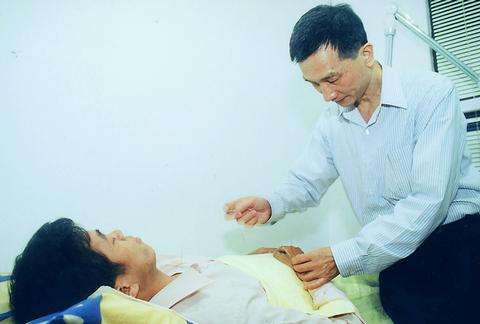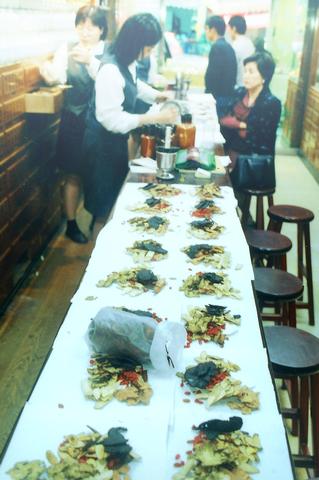China and Taiwan's WTO accession may be good for your health. To accompany its admission to the world trade body, China has announced that students from Taiwan, Hong Kong and Macau will be allowed to practice medicine in the mainland, prompting Taiwan to consider similar policy changes to open up its health fields.
Students of traditional Chinese medicine make up the biggest number of Taiwanese students in China's colleges. However, their Chinese degrees aren't recognized in Taiwan, putting graduates from those universities in an awkward position back home. A change in government policy might well provide more options for those who want to practice their trade in Taiwan.
Most people in the traditional Chinese medical field, however, don't believe that Taiwanese students would want to practice medicine in China due to the comparatively low pay offered by the Chinese government.

PHOTO: DAVID VAN DER VEEN, TAIPEI TIMES
Another factor is more philosophical in nature; as China has long combined Western and Chinese medical practices and education, Taiwan has become the only place for students to study -- and patients to receive -- traditional Chinese medicine unadulterated by Western influence.
This is the result of a focus on Western medicine in Taiwan that relegated traditional practices to medical dustbins. China's approach, which allows traditional medicine practitioners access to Western drugs and equipment is unheard of in Taiwan where Chinese medicine has preserved its antiquated methods.
Tradition versus innovation

PHOTO: DAVID VAN DER VEEN, TAIPEI TIMES
Acupuncture was introduced to Europe in the 17th century and has steadily developed there ever since. In the past 20 years in particular, it has become a widely accepted treatment due to the increased popularity of alternative therapies. The attention Western countries have given to Chinese medicine has prompted a revival of the ancient art form in Taiwan. "The current popularity of traditional Chinese medicine started in the West. ... Taiwan began paying more attention to it only later," said Kao Shang-de (
In the past, Chinese physicians learned their trade through apprenticeship. The start of the first traditional Chinese medicine department at China Medical College 43 years ago heralded the modernization of the ancient practice by placing it in the same department with Western medicine.
Combined with this is a medical certification system which involves certain tests for those who do not possess a degree in traditional Chinese medicine, and another test for those who do. Passing either of the exams can certify someone to practice Chinese medicine. Such a system allows anyone to be a traditional Chinese physician whether he or she has professional training or not. Because of the dangers inherent in the system, the special exams are scheduled to be abolished by 2011, making traditional Chinese medical education a requirement for everyone practicing Chinese medicine in Taiwan.

PHOTO: DAVID VAN DER VEEN, TAIPEI TIMES
Although traditional medicine education has emphasized clinical experience, graduates in the field were for a long time allowed to practice without having first gone through an internship. Only in recent years have internships become part of the curricula for Chinese medicine undergraduates.
Since the launch of National Health Insurance (
"The pitiful lack of statistics in the history of Chinese medicine reflects the mentality of physicians in the past to save face by intentionally omitting the cases where their treatment failed," said Chen Wang-chuan (

PHOTO: DAVID VAN DER VEEN, TAIPEI TIMES
Chinese medicine's former image was of dimly lit herb stores and kungfu houses providing snakeoil elixirs said to cure all ailments. The image has since been replaced by clean, bright clinics employing both physicians and physical therapists in several different departments, all covered by National Health Insurance. The prescriptions that were once filled by herbs needing to be boiled for hours are now "scientific Chinese drugs" -- powdered extracts or capsules that are convenient to take.
Although the medications' new form has delighted most patients, it has also caused concern among consumers who take both Western and traditional Chinese medicines in combination. According to Chen Ching-wen (
As Chinese herbs have been made more convenient for consumption, the government has endeavored to make them safer as well. Although only 51 of 323 drug manufacturers in Taiwan have been deemed by the Executive Yuan's Department of Health to have good manufacturing practices -- labeled on products as GMP -- the number is expected to rise as the department has vowed to certify all manufacturers within five years.
There also are those fighting the trend to modernize. One example is Tung Hsin Tang (同心堂), a bustling Chinese herb store that also offers in-house medical consultation. Instead of stocking shelves with plastic bottles filled with herbal extracts, the store displays a variety of dried plants, animals and minerals in classic wooden bins and drawers. "We aim to preserve Chinese medicine in its original form," said Lin Juan-er (林娟娥), the store's doctor. "Some people prefer using the original materials. The [modern] Chinese drugs and their more primitive forms are equally effective," she said.
For those accustomed to Western medical practices, however, a major drawback to Chinese clinics is the lack of scientific medical equipment. The main reason for this is government restrictions in Taiwan that prohibit the use of many devices found in Western-medicine clinics.
"It's cumbersome for traditional Chinese physicians not to be allowed to give an injection or use an X-ray machine. ... The irony is that the same herbs are alright when taken orally, but illegal when administered through a syringe. In contrast, China has long been open to combining Western and traditional methods in treatment and diagnosis, making health check-ups more convenient and the regiments prescribed more effective," said Chen Pi-cheng (
Tung Hsin's Lin agreed: "The basic method of diagnosing a patient is to observe them with the naked eye. [Scientific] equipment would greatly facilitate the detection of diseases and pathogens, and with greater accuracy."
This traditional unassisted method of diagnosis consists of checking a patient's pulse and observing their complexion, musculature and posture as well as examining their tongue, listening for sounds made by their internal organs and smelling their bodily secretions. The combination of information gathered through these methods reveals the patient's condition.
Many doctors claim that their ability to do without machinery is a demonstration of their expertise. "It often happens that a patient will have gone to a Western hospital for all manner of examinations and doctors are still unable to pinpoint [the cause of] the ailment. There are limitations to what machines can do," said Chen at the Tienmu clinic.
Apart from making use of Western facilities, a trend toward integrating examination equipment into the diagnosis process of traditional Chinese medicine has quietly begun with the Automatic Reflective Diagnosis System, a type of vein and artery diagnosis system. The first of these machines was installed in Chunghsiao Hospital's rehabilitation unit and has since reached the medical departments of most major universities in Taiwan.
The system, though still rarely found in regular clinics, is the only diagnostic instrument that diagnoses the liver, heart, spleen, lungs and kidneys as well as the five systems known in traditional medicine as "organ networks." The conditions which it can supposedly diagnose range from coronary diseases and sterility to melancholia and a patient's potential for developing cancer.
While the patient lies on an examination table, the doctor uses a device that resembles a pen on and about the patient's wrists and feet. After five minutes or so, all the information gathered by the system is displayed on a screen and printed in the form of six lists detailing the patient's condition. According to doctors, the system can help pinpoint the ailing organs and possible causes of the ailment by using tests such as an electrocardiograph and blood analysis. Although the printed diagnosis contains traditional medical terminology which must be interpreted by physicians, most of its content is easily understood by patients.
With the present regulations on scientific equipment in traditional Chinese clinics, the instruments may only be of limited help. For instance, if test results show there is something wrong with a person's kidneys, the patient must still go to the urology department in a Western-style hospital to receive treatment.
Not a panacea
Traditional medicine, like Western medicine, has its limits, and both are be effective in different ways. According to Chen Po-chuan (陳伯全), general internist at the Chinese medicine department of Chang Gung Memorial Hospital (長庚醫院), those who suffer from allergies or disorders that Western medicine fails to remedy are recommended to try the traditional approach, though success comes with no guarantee.
Many ailments brought about by an unhealthy modern lifestyle -- ailments which Western medicine has been unable to treat -- have provoked countries like Germany to turn to Chinese medicine. The present attention on Chinese herbs started in the later 1980s after German scientists discovered the benefits of Gingko Biloba in the treatment of coronary heart disease and the prevention of hypertension. The trend spread quickly to other European countries and served to remind Westerners of the ancient discipline. Now Chinese herbs are frequently used by people living with cancer and AIDS to avoid the often serious side effects brought by Western medications.
"Some terminal patients have turned to traditional Chinese medicine. But they must also know that traditional medicine may not guarantee a cure for them," said the Tienmu clinic's Chen. "Actually, Chinese and Western medicine should both be seen as effective options. Patients would benefit most from the combination of the two."

June 2 to June 8 Taiwan’s woodcutters believe that if they see even one speck of red in their cooked rice, no matter how small, an accident is going to happen. Peng Chin-tian (彭錦田) swears that this has proven to be true at every stop during his decades-long career in the logging industry. Along with mining, timber harvesting was once considered the most dangerous profession in Taiwan. Not only were mishaps common during all stages of processing, it was difficult to transport the injured to get medical treatment. Many died during the arduous journey. Peng recounts some of his accidents in

“Why does Taiwan identity decline?”a group of researchers lead by University of Nevada political scientist Austin Wang (王宏恩) asked in a recent paper. After all, it is not difficult to explain the rise in Taiwanese identity after the early 1990s. But no model predicted its decline during the 2016-2018 period, they say. After testing various alternative explanations, Wang et al argue that the fall-off in Taiwanese identity during that period is related to voter hedging based on the performance of the Democratic Progressive Party (DPP). Since the DPP is perceived as the guardian of Taiwan identity, when it performs well,

The Taiwan People’s Party (TPP) on May 18 held a rally in Taichung to mark the anniversary of President William Lai’s (賴清德) inauguration on May 20. The title of the rally could be loosely translated to “May 18 recall fraudulent goods” (518退貨ㄌㄨㄚˋ!). Unlike in English, where the terms are the same, “recall” (退貨) in this context refers to product recalls due to damaged, defective or fraudulent merchandise, not the political recalls (罷免) currently dominating the headlines. I attended the rally to determine if the impression was correct that the TPP under party Chairman Huang Kuo-Chang (黃國昌) had little of a

At Computex 2025, Nvidia CEO Jensen Huang (黃仁勳) urged the government to subsidize AI. “All schools in Taiwan must integrate AI into their curricula,” he declared. A few months earlier, he said, “If I were a student today, I’d immediately start using tools like ChatGPT, Gemini Pro and Grok to learn, write and accelerate my thinking.” Huang sees the AI-bullet train leaving the station. And as one of its drivers, he’s worried about youth not getting on board — bad for their careers, and bad for his workforce. As a semiconductor supply-chain powerhouse and AI hub wannabe, Taiwan is seeing